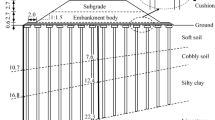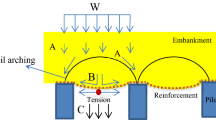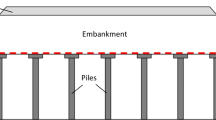Abstract
Column-supported embankments provide a practical and efficient solution for construction on soft soil due to the low cost and short construction times. In recent years, geosynthetics have been used in combination with column systems to support embankments. The load transfer mechanism in these systems is a combination of soil arching and membrane effect of the geosynthetics. In this paper, numerical method was used to improve the understanding of the long-term performance of geosynthetic-reinforced embankments supported on end-bearing piles. The distribution of skin friction, axial force distribution, settlements on the embankment and foundation soil surface, and vertical stresses on the pile head and foundation surface were studied. Finally, the results from the numerical studies were compared with the results from different analytical methods. Based on the numerical results obtained, modified arching coefficient is presented for end-bearing piles.
















Similar content being viewed by others
References
Abusharar SW, Zheng JJ, Chen BG, Yin JH (2009) A simplified method for analysis of a piled embankment reinforced with geosynthetics. Geotext Geomembr 27(1):39–52
Anjana B, Rajagopal K (2013) Numerical investigation of time dependent behavior of geosynthetic reinforced piled embankments. Int J Geotech Eng 7(3):232–240
Anjana B, Rajagopal K (2015) Geosynthetic-reinforced piled embankments: comparison of numerical and analytical methods. Int J Geomech 15(5):04014074-1–04014074-12
Biot MA (1941) General theory of three dimensional consolidations. J Appl Phys 12:155–169
BS8006-1 (2010) Code of practice for strengthened/reinforced soils and other fills. British Standard Institution, London
Cao WP, Zhao M (2012) Performance of floating piles for supporting embankments in soft soils. Appl Mech Mater 105–107:1433–1437
Collin JG, Watson CH, Han J (2005) Column-supported embankment solves time constraint for new road construction. In: ASCE geotechnical special publication (GSP) no. 131, contemporary issues in foundation engineering, ASCE Geo Frontiers, Austin, TX, January 24–26
CUR 226 (2010) Ontwerprichtlijn paalmatrassystemen (Design Guideline Piled Embankments). Stichting CUR, Gouda (in Dutch)
EBGEO (2011) Recommendations for Design and Analysis of Earth Structures using Geosynthetic Reinforcements – EBGEO
Guido VA, Knueppel JD, Sweeny MA (1987) Plate loading tests on geogrid-reinforced earth slabs. In: Proceedings of geosynthetics 87 conference, New Orleans, pp 216–225
Han J, Gabr MA (2002) Numerical analysis of geosynthetic-reinforced and pile-supported earth platforms over soft soil. J Geotech Geoenvironmental Eng 128(1):44–53
Hewlett WJ, Randolph MF (1988) Analysis of piled embankments. Ground Eng 21(3):12–18
Jenck O, Daniel D, Richard K (2009) Three-dimensional numerical modeling of a piled embankment. Int J Geomech 9(3):102–112
Jones CJFP, Lawson CR, Ayres DJ (1990) Geotextile reinforced piled embankments. In: Hoedt D (ed) Geotextiles, geomembranes and related products. Balkema, Rotterdam, pp 155–160
Kempfert HG, Gobel C, Alexiew D, Heitz C (2004) German recommendations for soil reinforcement above pile-elements. In: Proceedings of the third European conference on geosynthetics, EUROGeo3, Munich, Germany, pp 279–283
Lee CJ, Bolton MD, Al-Tabbaa A (2002) Numerical modeling of group effects on the distribution of drag loads in pile foundations. Geotechnique 52(5):325–335
Leng J, Gabr MA (2005) Numerical analysis of stress–deformation response in reinforced unpaved road sections. Geosynth Int 12(2):111–119
Liu HL, Charles WW, Fei K (2007) Performance of a geogrid-reinforced and pile-supported highway embankment over soft clays—case study. J Geotech Geoenvironmental Eng ASCE 133(12):1483–1493
Low BK, Tang SK, Choa V (1994) Arching in piled embankments. Electron J Geotech Eng 120(11):1917–1938
Marston A, Anderson AO (1913) The theory of loads on pipes in ditches and tests of cement and clay drain tile and sewer pipe. Bulletin No.3, Iowa State University Engineering Experiment Station, Ames, Iowa
McNulty JW (1965) An experimental study of arching in sand. Tech Report I-674, U.S. Army Engineer Waterways Experiment Station, Corps of Engineers, Vicksburg, Mississippi
SIMULIA (2009) ABAQUS/CAE user’s manual. Pawtucket, Rhode Island
Smith M, Filz G (2007) Axisymmetric numerical modelling of a unit cell in geosynthetic-reinforced, column-supported embankments. Geosynth Int 14(1):13–22
Terzaghi K (1923) Die berechnung der durshlassijg Jceitsziffer des tones aus dem verlaufder hydrodynamischen spannungsercheinungen (The calculation of the coefficieng of permeability of clays on the basis of hydrodynamic stress phenomena). Sitzungsberichte der Wiener Akademie der Wissenschaften (Mathematisch naturwissenschaftliche Klasse) 132:125–138
Terzaghi K (1943) Theoretical soil mechanics. Wiley, New York
Van Eekelen SJM, Bezuijen A, Van Tol AF (2011) Analysis and modification of the British Standard BS8006 for the design of piled embankments. Geotext Geomembr 29:345–359
Yao W, Liu Y, Chen J (2012) Characteristics of negative skin friction for super-long piles under surcharge loading. Int J Geomech 12(2):90–97
Yoo C, Kim SB (2009) Numerical modeling of geosynthetic encased stone columns. Geosynth Int 16(3):116–126
Zhan C, Yin JH (2001) Elastic analysis of soil-geosynthetic interaction. Geosynthetics Int 8(1):27–48
Acknowledgements
The authors wish to acknowledge Science Engineering Research Board (SERB), India for the financial support for this research work through the grant ECR/2017/000445.
Author information
Authors and Affiliations
Corresponding author
Rights and permissions
About this article
Cite this article
Roy, R., Bhasi, A. Investigation of Arching Effect in Geosynthetic-Reinforced Piled Embankments. Iran J Sci Technol Trans Civ Eng 43 (Suppl 1), 249–262 (2019). https://doi.org/10.1007/s40996-018-0162-8
Received:
Accepted:
Published:
Issue Date:
DOI: https://doi.org/10.1007/s40996-018-0162-8




